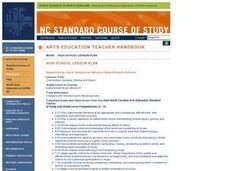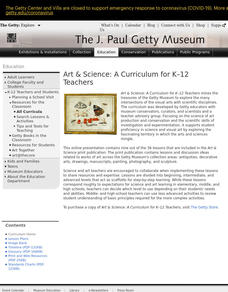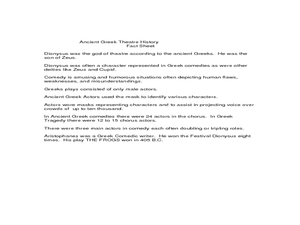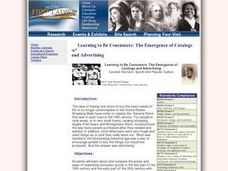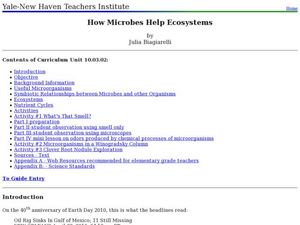Curated OER
Polymerization Experiments
Students study the concepts of polymerization and the function of crosslinkage. In this polymer lesson students complete a lab activity and write down their observations.
Curated OER
Connecting Literature, Writing and Music
Students assess the impact of music to portray emotions and tell stories. Examples are taken from the life of Rosa Parks and a piece of band music called "A Movement for Rosa". Evaluation is accomplished through in-class participation...
Curated OER
Real Math
Students explore careers that require math knowledge and solve real life math problems. As a class, they compare and contrast classroom math to real life math and explore the links between algebra, geometry and math skills used in...
Curated OER
Clearly Classified
Young scholars review the classification system for living organisms and apply it the classification of insects and flowers in the still life by Ambrosius Bosschaert. They create a chart classifying the animals and plants in the painting...
National First Ladies' Library
All the News That's Fit to Draw: Political Cartooning and the Presidency
Students research, analyze and study the history of political cartooning in the United States. They recognize a political cartoon, be able to identify the main idea, the symbols and the exaggeration and caricature in political cartoons....
Curated OER
Where are the Dinosaurs?
Students construct their own diorama based on the life of a dinosaur. In this dinosaur lesson, students create models of dinosaurs and dinosaurs' eggs to explore the life cycle of this extinct species.
Curated OER
Understanding Treaties: Students Explore the Lives of Yakama People Before and After Treaties
Students analyze treaties made between the US government and Native American tribes. In this government lesson plan, students evaluate bias emotionally connect with what was gained and lost during the late 1700's. This is a 3 part...
Benjamin Franklin Tercentenary
Guess What Benjamin Franklin Did!
Learners research Ben Franklin's inventions. In this invention lesson, students see the relationship between a need and an invention. Learners will engage in a class discussion, read a handout, and play a match the invention to its...
National First Ladies' Library
A Settlement House Hall of Fame
Young scholars identify, interpret and define a great deal about the Settlement House Movement of the Progressive Era, as well as about the women who were largely responsible for bringing the movement to life. They also research the life...
Curated OER
Biospheres
Second graders create models, practice inquiry skills, work with fellow students in teams, and reinforce concepts discussed in class all by using the theme of BIOSPHERES.
Curated OER
To Culture or Not to Culture
Students study the pros and cons of the aquaculture industry after reading hypothetical case study. They simulate a town meeting debate about aquaculture.
Curated OER
Dancing with Dionysus
Sixth graders research Ancient Greek culture by acting in a play for the festival of Dionysus. In this Greek culture lesson, 6th graders study an ancient Greek map and the Sarcophagus Dionysus from the Walters Art Museum website....
Curated OER
Mean, Median, Mode and Range
Mean, median, mode, and range lessons can link math to real life experiences.
Curated OER
Women Monarchs and Heads of State: World History, Women's Studies
Students research women leaders and construct a dramatic panel in which these leaders compare and contrast their reigns.
National First Ladies' Library
Politics! Politics! The Emergence of Political Parties in the U.S.
High schoolers are split into six small groups which focus on one of six websites, that tell the story of the emergence of the Federalist and Democratic-Republican parties at the end of the 18th century. They compile a chronological list...
Curated OER
Roosevelt's New Deal
Tenth graders examine what President Franklin Roosevelt's New Deal was, examine the New Deal programs, and realize how the New Deal still affects American lifes today. They search the Internet for information about these topics in this...
Curated OER
Biodegradability
Learners study the effects of water, salt water and heat on common household materials. They separate an emulsion and show that the materials are completely recoverable and observe the effect of acetone and water on polystyrene.
Curated OER
Roots And Styles Of Black Music - Lesson 1
Students identify many genres of Black music. They identify Black music as a reflection of the culture. They study many historically influential Black music artists, producers, and other contributors.
Curated OER
Fishing For The Future
Students participate in a simulation using M&M's that highlights Garrett Hardin's concept of the "tragedy of the commons." They use the activities to study sustainability issues in the fishing industry.
National First Ladies' Library
The First Great Awakening
Connecting social studies and American literature, students study the Great Awakening and draw comparisons between its impact on England and on parts of Colonial America. They research the lives and experiences of people who lived during...
National First Ladies' Library
Learning to Be Consumers: The Emergence of Catalogs and Advertising
Learners study the historical context of marketing and how it came to be so important in the 19th century. They analyze advertising in the 19th century, 20th century, and today to understand how much or how little has changed.
Curated OER
A Demonstration of Photo-and Geotaxes in Nauplii of Artemia Salina
High schoolers explore phototaxis and geotaxis in brine shrimp. In this phototaxis and geotaxis lesson plan, students study the effects of light and gravity on brine shrimp using a test tube, a pen light and gravity. They answer...
Curated OER
Breaking the Chains: Rising Out of Circumstances
Study history through photographs. In this visual arts and history lesson, young scholars learn to analyze photographs to discover details about life during the Civil War era. Students write journal entries as if they are the...
Curated OER
How Microbes Help Ecosystems
Sixth graders observe different microorganisms under the microscope. In this biology lesson, 6th graders draw and describe the samples they see. They study the root nodules of plants and explain how the plants benefit from those bacteria.

